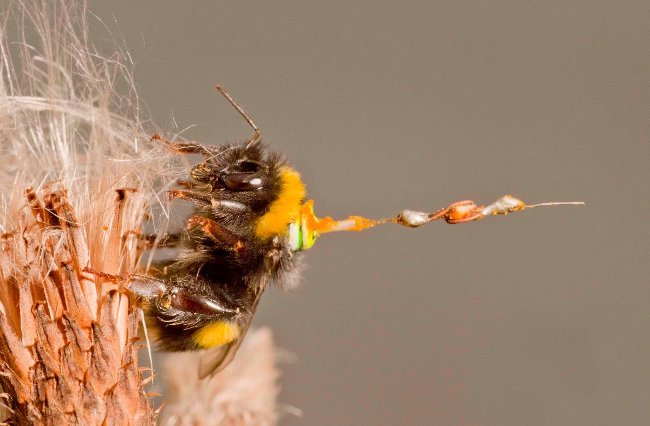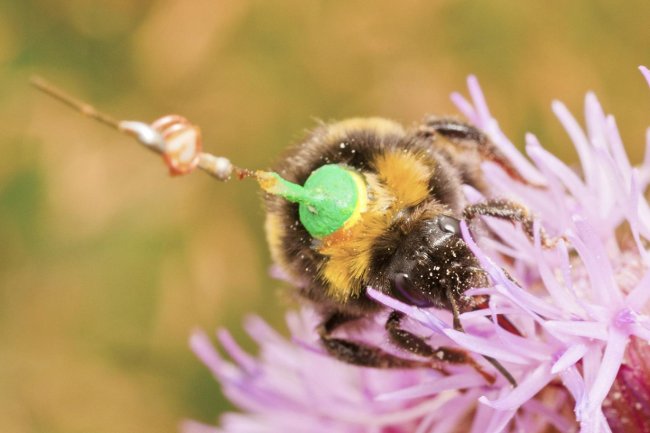British scientist uses radar to track bee's lifelong route
For the first time, scientists conduct research to track the flight path of bees throughout their lifetime. That result helps biologists to better understand the activity of bees. In addition to bees, insects also play an important role in pollinating crops. Understanding the movements of bees, can help farmers manage their farming better.

Joseph Woodgate at Queen Mary University in London, along with his colleagues, used radar to track the daily routes of four different bees since they left the nest until they no longer returned. Because each radar can only track one bee, researchers have to place four different beehives at four different times to track each one.
Research coordinator Lars Chittka replied with a press release saying: "At first, we were able to record the whole 'life story' of a bee. At first, she flew. going out and seeing daylight completely different from the current world around her, she flew out and became an experienced hunter in an environment full of honey but full of clues. Dangerous threats such as being able to lose their lives in the hands of predators or inadvertently go too far from their nest. "

To monitor every insect activity, scientists used glue to attach to each bee's body a radar system that received and emitted 16-millimeter-long signals. Radar antennas do not harm or interfere with all day-to-day activities of bees like spending the day searching for food in a vast field of flowers and starches in Hertfordshire, England. From the four bees' radar, the scientists collected information about 244 flights, about 15,000 minutes long and more than 111 miles away.
Previous studies have shown that bumblebees go to places to search or harvest food to harvest. But they have been searching and exploiting for how long they have not proven.
The researchers wrote: " One of the most striking results when studying that is the magnitude of each different bee " in an article published in PLoS ONE magazine .
Example: The number 1 bee spends most of their time exploiting food - about 90% more but bee number 2 and bee number 3 spend more time to explore. In their expeditions, the numbers 1 and 3 are not as far away as the No. 2 and No. 4 bees. The numbers 1 and 4 are often changed to their flights during the search for food and Never return to the original location they were looking for.

Each image describes the activity of a bee's life, its nest displayed with a blue circle.Each individual flight is displayed in a different color: the nearest flight (blue), further flight (yellow) and the last flight (red).
The study details the shortest and longest life cycle of a bee. Their longest life cycle is one month, while most bees usually die earlier. In this study, bee number 2 only lived for 6 days and it was a bee with the shortest life cycle. Once, the scientists happened to see the number 2 bee still in the field after sunset. It parked under a flower on the star fruit tree. Since bees do not fly at night, the bee must sleep on the trunk.
The next morning, the scientists woke up before dawn and found the bee still sitting under the flower. At 8:15 am, she began to search for food in nectar.
On the sixth day, she had a fast flight, heading southeast and flying out of the radar range. She saw a star fruit tree like the one she had parked the night before, the plan to find food was repeated again until the sun rose. But unfortunately, a violent storm last night brought her away and never returned.
You should read it
- Git life cycle
- The suspect on the network was arrested after the provider shared VPN access history with the FBI
- 5 applications to help you track the activity of the storm easily
- Online anti-malware tool
- How to change the route on Google Maps
- Accurate weather forecast applications on the phone
- Google invests in news sites with robots as robots
- Panda launched antivirus software through the Web
May be interested
- The number of honey bees in the world decreased by nearly 12%
 beekeepers in 29 countries report that of the nearly 400,000 honey bees they manage, 11.9% of them cannot survive the winter.
beekeepers in 29 countries report that of the nearly 400,000 honey bees they manage, 11.9% of them cannot survive the winter. - Steps to use Track Changes in Excel
 track changes in excel will review the content editing history in excel, highlight content changes and make notes in the data table so you can easily track.
track changes in excel will review the content editing history in excel, highlight content changes and make notes in the data table so you can easily track. - British Airways has a systematic, delaying 'error' at many airports in the UK, customers dumping stone tiles on Twitter
 british airways, one of the most respected civilian airlines in the world, is experiencing horrible hours, perhaps only in the wake of a crash.
british airways, one of the most respected civilian airlines in the world, is experiencing horrible hours, perhaps only in the wake of a crash. - Expert: There will be no lifelong immunity to SARS-CoV-2
 a russian expert said that immunity to the new strain of coronavirus (sars-cov-2) that causes covid-19 acute respiratory infections will not be sustainable and is not a lifelong form of immunity.
a russian expert said that immunity to the new strain of coronavirus (sars-cov-2) that causes covid-19 acute respiratory infections will not be sustainable and is not a lifelong form of immunity. - New research: audible flowers and the flapping of bee wings make honey more sweet
 according to scientists, the flowers can listen to bees and make their honey sweeter to lure the bees to pollinate.
according to scientists, the flowers can listen to bees and make their honey sweeter to lure the bees to pollinate. - MS Word - Lesson 17: Track Changes tool
 track changes is a special feature of word, allowing you to see changes made to a document. track changes tools are available in the reviewing tab on the ribbon.
track changes is a special feature of word, allowing you to see changes made to a document. track changes tools are available in the reviewing tab on the ribbon. - How to fix when iPhone maps do not show route
 what to do when iphone maps do not show the route? ifan, don't worry, see the cause and solution below from tipsmake.
what to do when iphone maps do not show the route? ifan, don't worry, see the cause and solution below from tipsmake. - If you want to be a data scientist, learn these 3 languages right away!
 the demand for skilled developers of data science continues to increase. if you want to work in this area, these are the things you need to learn.
the demand for skilled developers of data science continues to increase. if you want to work in this area, these are the things you need to learn. - DNA analysis showed that the first modern British had dark skin, blue eyes
 the first modern british had dark skin and blue eyes, london scientists said after analyzing breakthrough dna about the body of an ancient person who lived 10,000 years ago.
the first modern british had dark skin and blue eyes, london scientists said after analyzing breakthrough dna about the body of an ancient person who lived 10,000 years ago. - Climate change puts bees at risk of extinction, but it's not too late for humanity to save them and save themselves
 in a recently published scientific report, researchers claim climate change is the cause of bees' extinction.
in a recently published scientific report, researchers claim climate change is the cause of bees' extinction.










 Unique workspace of famous companies
Unique workspace of famous companies What does the ancient world look like in the eyes of dinosaurs?
What does the ancient world look like in the eyes of dinosaurs?